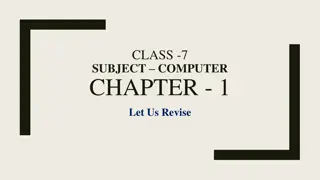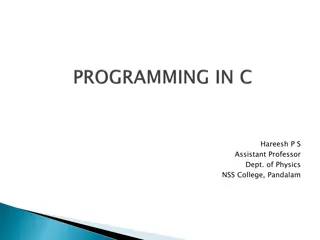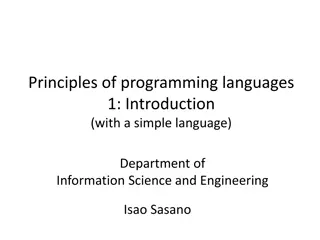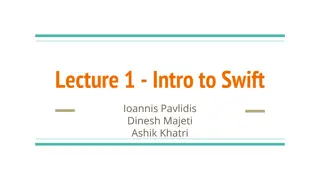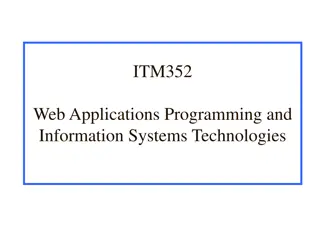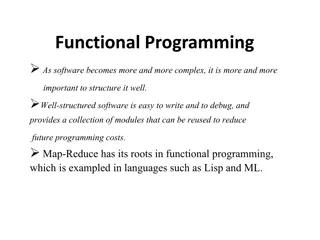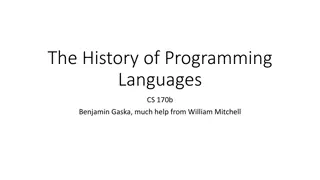Introduction to Programming in C Language
C language is a procedural programming language developed by Dennis Ritchie in 1972. Known for its low-level access to memory, simple keyword set, and clean style, C is ideal for system programming tasks like operating system and compiler development. This article covers key aspects of C language, Program Development Life Cycle (PDLC), problem definition, program design, algorithm development, coding, testing, and implementation. It guides programmers through steps for efficient program development and solution implementation.
Download Presentation

Please find below an Image/Link to download the presentation.
The content on the website is provided AS IS for your information and personal use only. It may not be sold, licensed, or shared on other websites without obtaining consent from the author.If you encounter any issues during the download, it is possible that the publisher has removed the file from their server.
You are allowed to download the files provided on this website for personal or commercial use, subject to the condition that they are used lawfully. All files are the property of their respective owners.
The content on the website is provided AS IS for your information and personal use only. It may not be sold, licensed, or shared on other websites without obtaining consent from the author.
E N D
Presentation Transcript
C LANGUAGE C language is a procedural programming language . It is developed by Dennis Ritchie in 1972. It works on top to down approach. It was mainly developed as a system programming language to write operating system. The main features of C language include low-level access to memory, simple set of keywords, and clean style, these features make C language suitable for system programming like operating system or compiler development.
PROGRAM DEVELOPMENT LIFE CYCLE PDLC(Program Development life cycle): Program Development life Cycle & Software Development Life Cycle. The programming development cycle is a process of steps, used by programmers to more efficiently manage their time in designing error-free programs that produce the desired output. PDLC(Program Development life cycle):- - STEPS OF PDLC:- There are seven steps of pdlc are following as: i. ii. Problem Design. iii. Algorithm Development & flow chart. iv. Program Coding . v. vi. Program testing. vii. Implementation and documentation. Problem Definition. Compilation & Debugging.
PROBLEM DEFINITION PROGRAM DESIGNING IMPLIMENTATION AND DOCUMENTATION ALGORITHM AND FLOWCHART PROGRAM TESTING DEBUGGING AND COMPILATION PROGRAM CODING
1. In this phase, we define the problem statement and we decide the boundaries of the problem. In this phase we need to understand the problem statement, what is our requirement, what should be the output of the problem solution. These are defined in this first phase of the program development life cycle. 1. Problem Definition : Problem Definition :- - 2. Language (or PDL, for short) is a method for designing procedures in software 2. Program Design : Program Design :- - designing and documenting methods and software.
3. During this phase, we develop a step by step procedure to solve the problem using the specification given in the previous phase. That means we write the solution in step by step statements. 3. Algorithm Development and Flowchart: Algorithm Development and Flowchart:- - FOR EXAMPLE:- // Write a algorithm for addition of two numbers. Step 1: Start Step 2: Declare variables num1, num2 and sum. Step 3: Read values num1 and num2. Step 4: Add num1 and num2 and assign the result to sum. Sum num1+num2. Step 5: Display sum Step 6: Stop
4. This phase uses a programming language to write or implement actual programming instructions for the steps defined in the previous phase. That means we write the program to solve the given problem using programming languages like C, C++, Java etc. 4.Program Coding : Program Coding :- - PROGRAM CODING FORMAT #include<stdio.h> #include<conio.h> void main() { --------------- ; --------------- ; }
// WRITE A PROGRAM FOR ADDING TWO NUMBERS. #include<stdio.h> int main() { int a, b, c; printf("Enter two numbers to add\ \n n"); scanf("%d%d", &a, &b); c = a + b; printf("Sum of the numbers = %d\ \n n", c); return 0; }
5. 5.Debugging & Compiling: Debugging & Compiling:- - Debugging some wrong code. So locating the wrong code by running the application with special tools (debugger) is called debugging. Debugging - - The Bugs found above are the causes of Compiling into an executable (Application). This is applicable to compiled languages such as C, C++. It helps to finding the errors present in the program coding. Its help in debugging process in removing the errors. Compiling- - Compiling is a process of converting code
6. There are other testing types such as Unit testing, Integration testing, Stress testing etc. If there are problems encountered while testing, they are termed as Bugs. 6.Testing Testing: :- - 7. Implementation organization, dependent largely on the details of the actual strategic plan, but some basic steps can assist in the process and ensure that implementation is successful Documentation the programmer at a later date, to understand the program. Internal documentation consists of statements in the program that are not executed, but point out the purposes of various parts of the program. 7.Implementation and documentation Implementation process can vary from organization to Implementation and documentation: :- - Documentation is intended to allow another person, or
DIFFRENCE B/W PROGRAM DEBUGGING AND TESTING DIFFRENCE B/W PROGRAM DEBUGGING AND TESTING PROGRAM TESTING PROGRAM TESTING PROGRAM PROGRAM DEBUGGING DEBUGGING 1. Testing always starts with known conditions, uses predefined methods, and has predictable outcomes too. 2. Testing can and should definitely be planned, designed, and scheduled. 3. It proves a programmers failure. 1. Debugging starts from possibly un-known initial conditions and its end cannot be predicted, apart from statistically. 2. The procedures for, and period of, debugging cannot be so constrained. 3. It is the programmer s vindication. 4. It is a demonstration of error or apparent correctness. 5. Testing purpose is to find bug. 4. It is always treated as a deductive process. 5. Debugging purpose is to find cause of bug.





